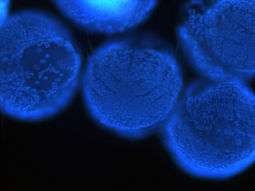Platynereis
Platynereis is a genus of marine annelid worms.[1][2]
| Platynereis | |
|---|---|
 | |
| Larvae of Platynereis dumerilii | |
| Scientific classification | |
| Kingdom: | |
| Phylum: | |
| Class: | |
| Order: | |
| Suborder: | |
| Family: | |
| Genus: | Platynereis Kinberg, 1865 |
| Wikimedia Commons has media related to Platynereis. |
| Wikispecies has information related to Platynereis |
The species Platynereis dumerilii is used in development biology to study development (embryogenesis), in particular because their embryos are largely transparent, and thus easy to follow.[3] Apical organs such as this one are photosensitive which is a key component in their formation. They also have a common ancestor with cnidarians and bilaterians.[4]
Species[5]
- Platynereis abnormis
- Platynereis antipoda
- Platynereis arafurensis
- Platynereis australis
- Platynereis bengalensis
- Platynereis bicanaliculata
- Platynereis calodonta
- Platynereis cebuensis
- Platynereis coccinea
- Platynereis cristatus
- Platynereis dumerilii
- Platynereis festiva
- Platynereis fuscorubida
- Platynereis hugonis
- Platynereis hutchingsae
- Platynereis insolita
- Platynereis karaka
- Platynereis kau
- Platynereis magalhaensis
- Platynereis mahanga
- Platynereis massiliensis
- Platynereis megalops
- Platynereis mucronata
- Platynereis nadiae
- Platynereis pallida
- Platynereis patagonica
- Platynereis polyscalma
- Platynereis pulchella
- Platynereis sinica
- Platynereis tongatabuensis
- Platynereis uniseris
gollark: Brain[REDACTED] sine wave generator WHEN?
gollark: What systems?
gollark: Well ,yes .
gollark: No.
gollark: <@!160279332454006795> Ideas?
References
- Kinberg1865, J. G. H. (1865). "Annulata nova. [Continuatio.]". Öfversigt af Königlich Vetenskapsakademiens förhandlingar, Stockholm (in Latin). 22 (2): 167–179. Retrieved 6 August 2018.
- Read, G.; Fauchald, K. "World Polychaeta database. Platynereis Kinberg, 1865". World Register of Marine Species. Retrieved 6 August 2018.
- Fischer, A. H.; Henrich, T.; Arendt, D. (2010). "The normal development of Platynereis dumerilii (Nereididae, Annelida)". Frontiers in Zoology. 7: 31. doi:10.1186/1742-9994-7-31. PMC 3027123. PMID 21192805.
- "Larval body patterning and apical organs are conserved in animal evolution". https://bmcbiol.biomedcentral.com/. 24 January 2014. External link in
|website=(help) - Bisby F.A., Roskov Y.R., Orrell T.M., Nicolson D., Paglinawan L.E., Bailly N., Kirk P.M., Bourgoin T., Baillargeon G., Ouvrard D. (red.) (2011). "Species 2000 & ITIS Catalogue of Life: 2011 Annual Checklist". Species 2000: Reading, UK. Retrieved 24 September 2012.CS1 maint: multiple names: authors list (link)
This article is issued from Wikipedia. The text is licensed under Creative Commons - Attribution - Sharealike. Additional terms may apply for the media files.